Juniper berries are commonly known as being a spice or being the flavoring for gin, but they have many other uses as well! Foraging for juniper berries is easy as juniper trees are fairly common. Learn more about foraging juniper berries and how to use them for food and medicine!
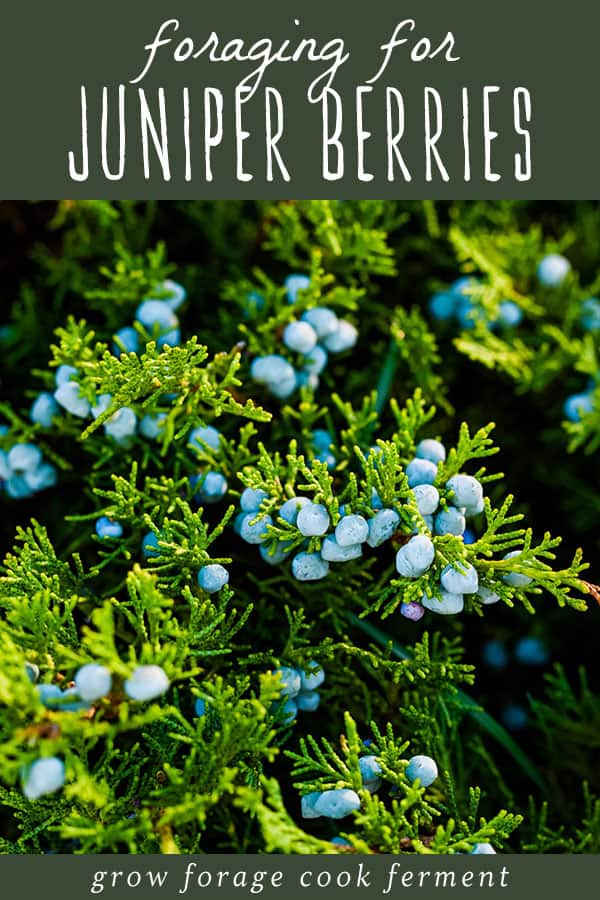
Wildcrafting Weeds
If you want to learn more about the edible and medicinal weeds that surround us and how to use them, check out my eBook: Wildcrafting Weeds: 20 Easy to Forage Edible and Medicinal Plants (that might be growing in your backyard)!
Foraging Juniper Trees & Berries
Joel and I were in Tahoe one winter and I said to him, “I’m sure we can find some Juniper trees while we’re here.” After spending many years in Yosemite, I figured Juniper trees were fairly common in the Sierras, but we didn’t see any in Tahoe!
However, not more than a week later, when I was back home and walking on a different route than usual due to serious heavy rains that flooded my regular path, I found a stand of Juniper trees with some plump berries.
So, right here at home and in town, I was foraging for juniper berries!
That’s the thing about juniper trees (Juniperus spp.), they are fairly common throughout the northern hemisphere, and some species are even planted as a ornamental tree in landscaping.
Juniper trees and berries, like most conifers, are great for fall foraging and winter foraging.
Junipers have needle or scale like leaves, depending on the species. Some have needles when young that turn to scales as they mature.
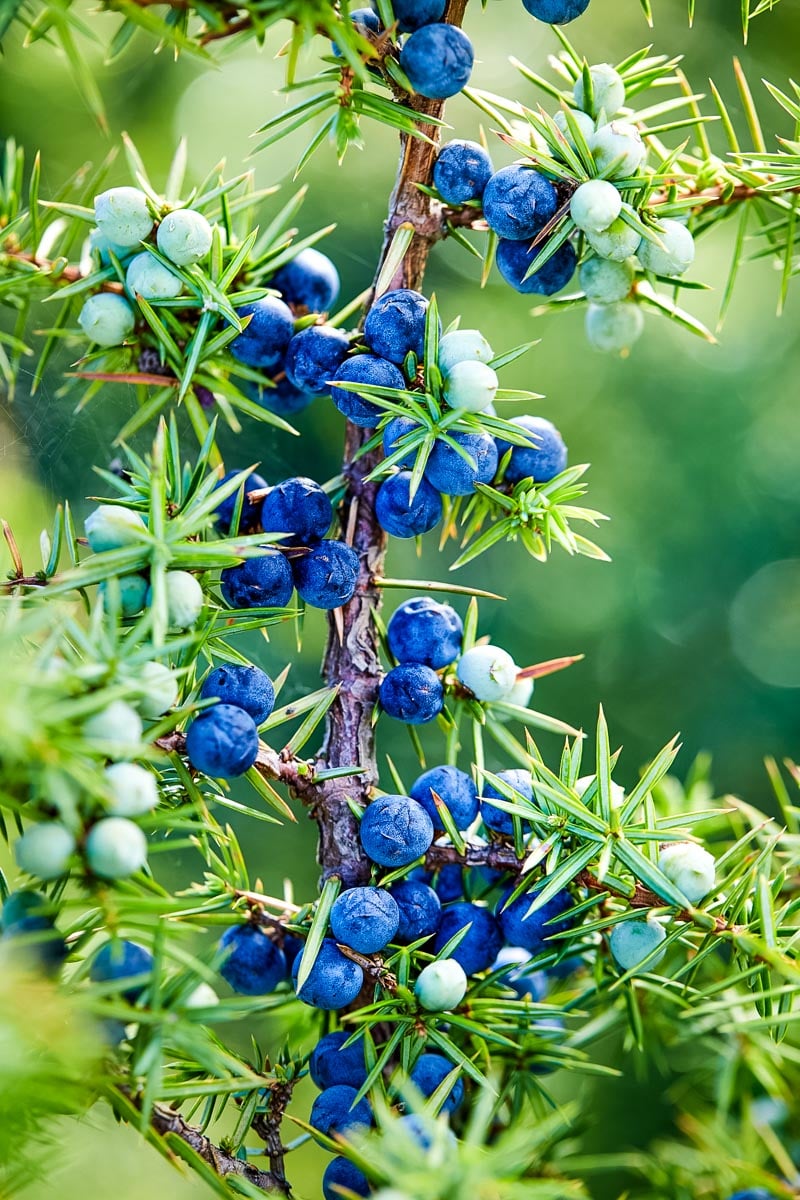
Beautiful and fragrant, juniper trees have become a favorite of mine over the years. They often have a gnarly and weathered look to them that I find pleasant.
Junipers have a distinctive aromatic “gin-like” scent and produce blue seed cones known as juniper berries, which is what we’re interested in today!
Note: Eastern redcedar (Juniperus virginiana) is actually a juniper and not a cedar at all!
Identifying Juniper Berries
The “berries” of juniper trees are actually fleshy cones, not true berries at all, that are usually covered with a white powdery bloom. That bloom is actually wild yeast, and you can use the berries to make your own wild yeast starter for homebrewing!
One thing to mention, there are certain varieties of juniper berries that contain a powerful resin that is toxic to humans if eaten in large amounts. Please be aware of this.
The best way to determine this is to taste a tiny bit of a berry and if it is harsh and bitter spit it out and do not use internally. Don’t worry, they are only mildly toxic and you would need to eat a lot of them to do any harm, so a tiny nibble isn’t a problem in this case.
But please don’t do with with other wild berries unless you are certain of their identification!
I have done this test before with juniper berries and have only ever had them taste wonderfully piney and slightly sweet, not even a hint of bitterness. Amazing, actually!
Related: How to Identify Conifer Trees: Pine, Fir, Spruce, Juniper & more!
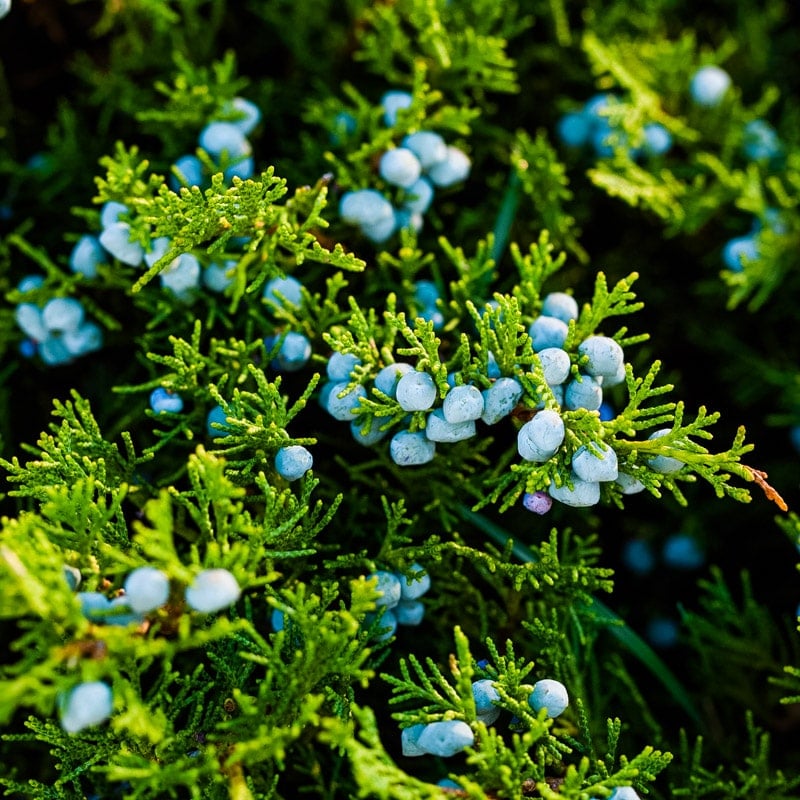
Edible Uses of Juniper Berries
Juniper berries are the primary flavoring agent for gin, and they are in an ingredient in my Infused Winter Gin recipe.
In fact, the name “gin” is derived from either the French or Dutch (no one knows for sure) word for juniper. But, juniper berries are good for so much more than just gin!
Dried juniper berries are commonly used as a spice or flavoring agent in brines and meat, particularly for game birds and venison. I use juniper berries in the brine for my nitrate free corned beef recipe.
They are common as a pickling and fermenting spice as well. I’ve used dried juniper berries in my fermented sauerkraut and love the subtle flavor it gives.
These juniper berry cookies are a festive and delicious way to use them as well!
Dried juniper berries can purchased from Mountain Rose Herbs. They also carry a pickling spice blend that contains juniper berries.
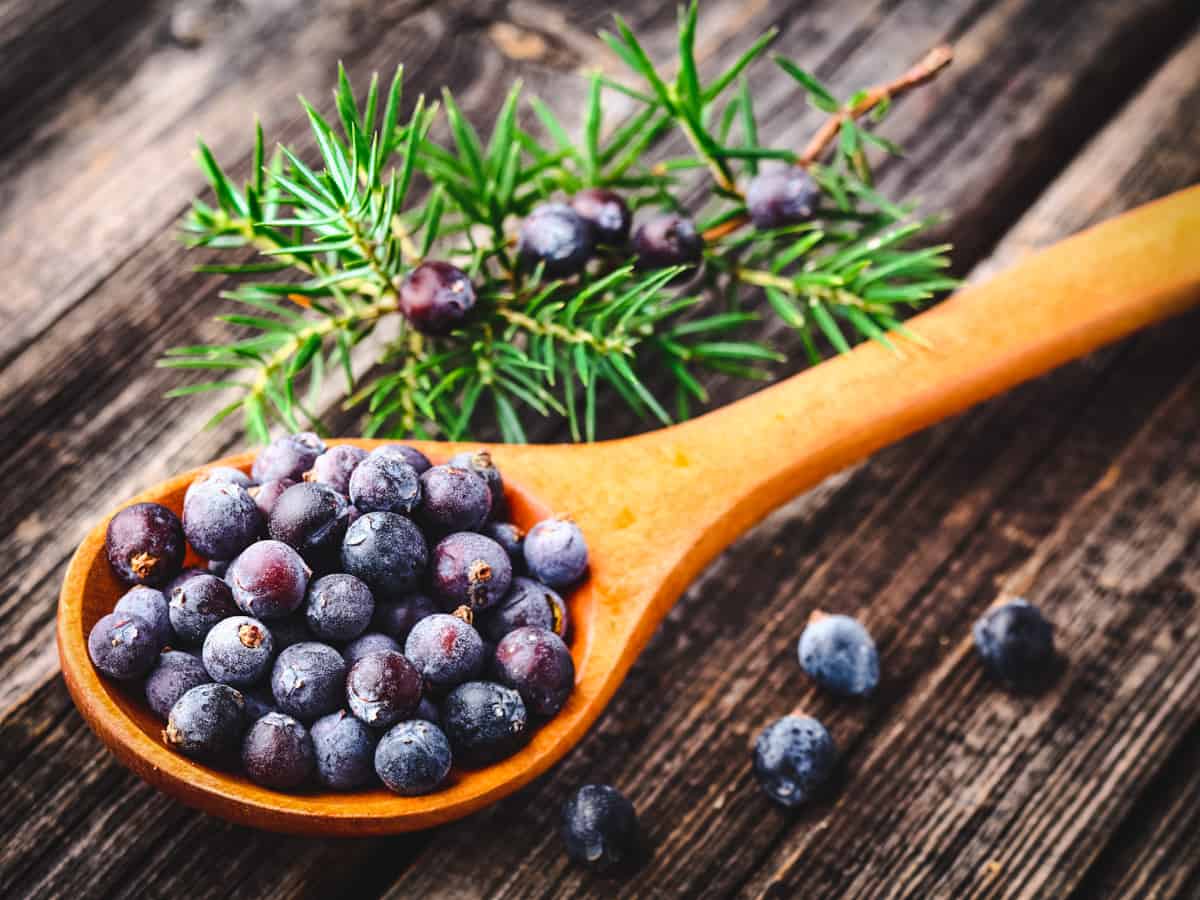
Medicinal Uses of Juniper Berries
Juniper berries are also a highly effective medicinal, as I can attest to from first hand experience.
They are most notably a powerful diuretic, along with being antiseptic and antiviral, making them extremely effective in treating UTI’s (urinary tract infections).
I have been prone to these horrible and painful infections in the past, and after deciding to quit taking unnecessary antibiotics when I was in my mid-twenties, I started drinking uva ursi and juniper berry tea whenever I felt one coming on.
I’m not going to lie, the pain was still there, but after 2 or 3 bouts within a year or so I was able to combat the infection for good and haven’t had one since… more than 15 years later!
I have a recipe in my book Healing Herbal Infusions for a UTI Tea that contains juniper berries, uva ursi, and some other herbs that are also beneficial for the urinary system.
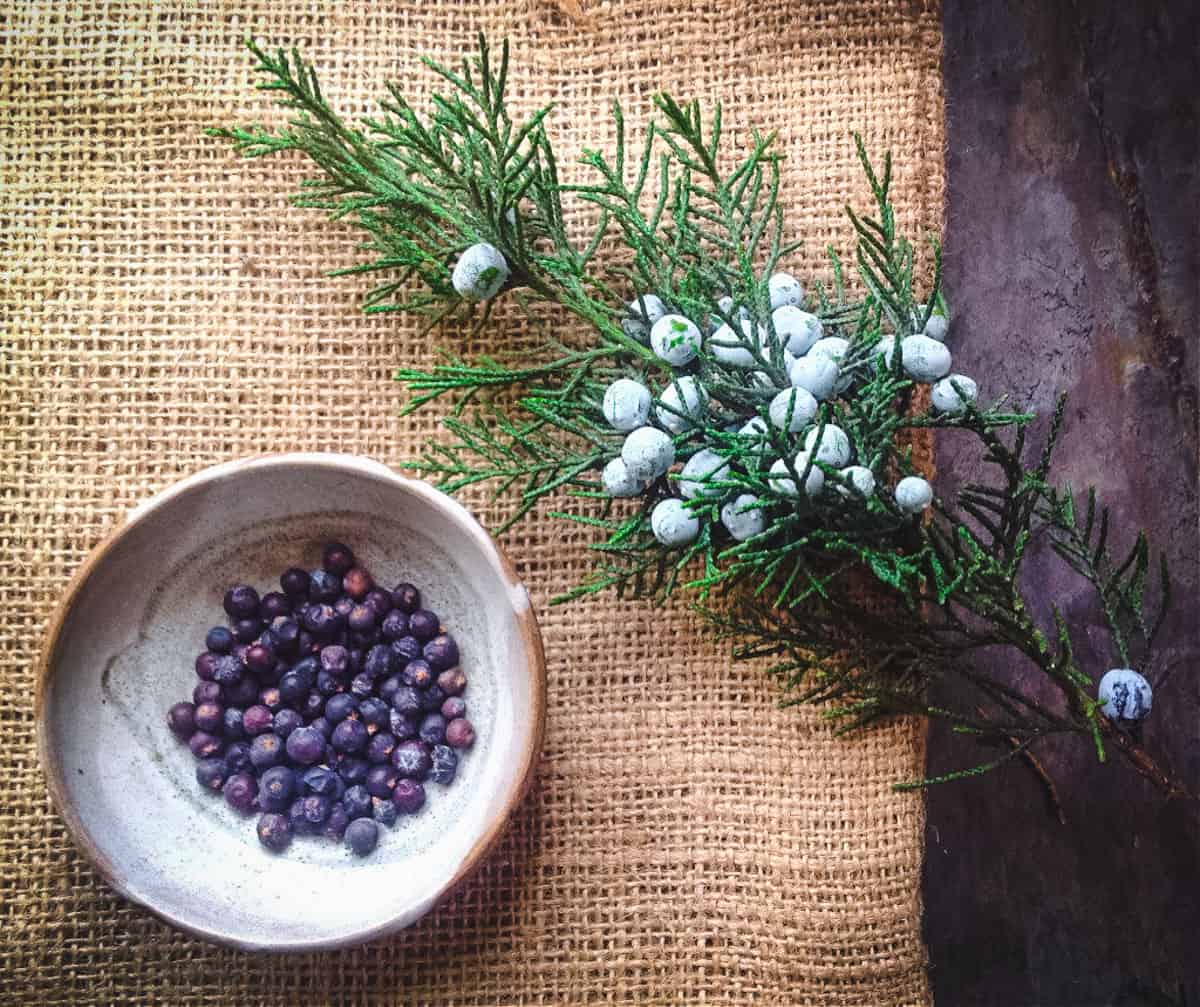
Juniper and its berries are also amazingly beautiful and have a wonderful incense like fragrance. If nothing else, it will look and smell pretty in your home and provide some aromatherapy.
Or you can turn it into an amazing smelling Juniper Spice Beard Balm for that bearded person in your life!
But for now, although Juniper berries are more than just gin, please don’t forget about the gin!
Go have a martini and think about how wonderful juniper berries are. You can thank me later!
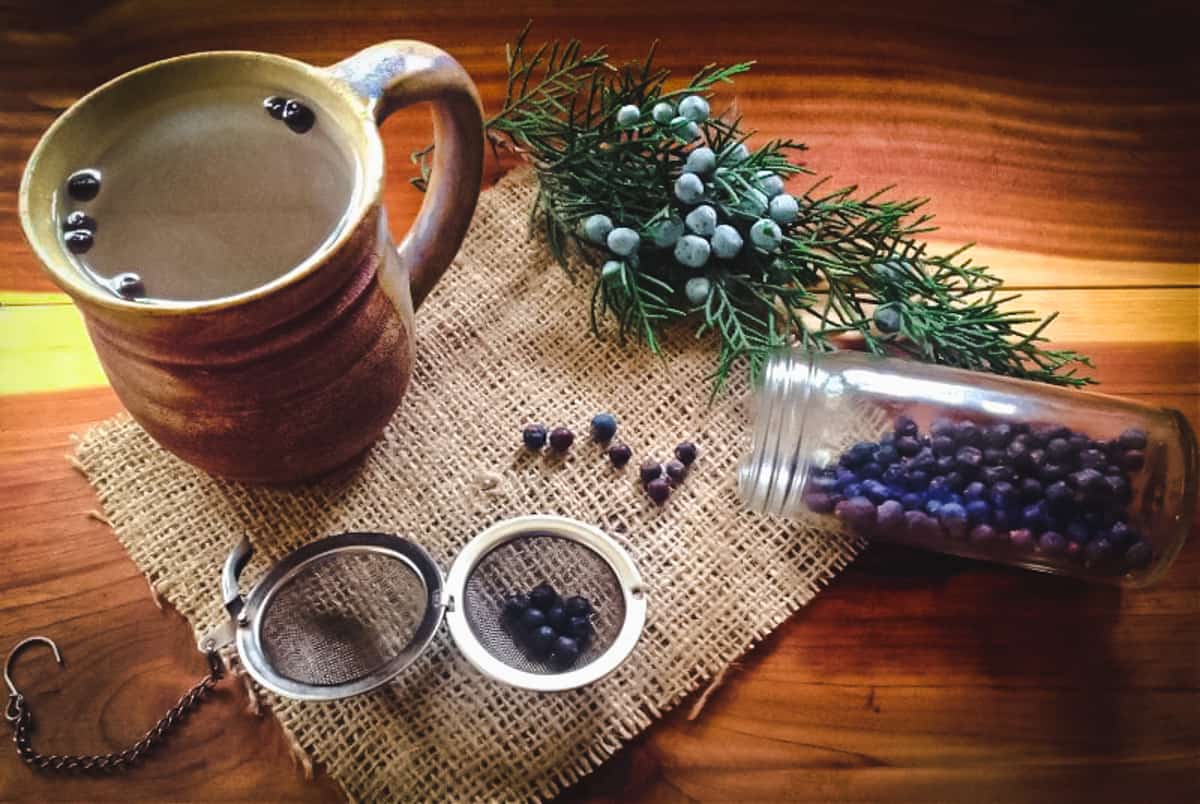

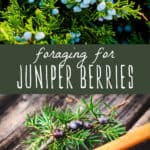

On our farm in KY we have an abundance of Eastern Red Cedars. Thank you for the collection of recipes. They are loaded this year!!!
This website is so ad-infested that I couldn’t read the article.
Sorry, Jerry. The ads are what allow me to continue to offer free content to my readers while still keeping the lights on.
Nice article. I use Juniper berries in an IPA. I use about 2 oz. of the berries at three different times during the boil, much like hop additions. Nice subtle juniper taste and aroma.
Juniper trees grow wild all over eastern Nebraska. They are a problem in pastures. Some have been planted along a bike trail I use and this year they are loaded with berries. Will give them the taste test soon.
Juniper berries and Oregon grape berries and a tea made from the OG root and stems are also very useful for all manner of health purposes and fixes ! The OG is quite amazing stuff as well the Juniper. I use both in my dandelion and mint tea for kidney/liver/blood pressure fixes and it all tastes great and works far better than any pharma
Thanks for sharing! I like using them in tea too!
From what I’ve read, the Cherokee used juniper berries as an abortive or birth control.
My mom would make a very effective cough syrup she called “Juniper Tar ” from these berries. I’ve been asking around for years about how to make it but no one seems to have heard of it.
I actually found several unopened bottles still in original wrapper with corks intact in original box when I cleaned out a cabinet at my now deceased 94 yr. Old MILS house!
https://www.merriam-webster.com/dictionary/juniper%20tar
Not sure if you mom used juniper tar in a recipe or if this link is helpful, but was curious to see if I could find the cough syrup referenced anywhere. So far only seeing the oil derived from the wood.
It sounds simple , boil simmer the berries , with that liquid simmer on a low heat reduce the liquid and may add some sugar or honey
What time of year is the best time to find fresh juniper berries?
Hello. I was hiking in the Oregon Badlands, east of Bend. I collected some juniper berries I was going to infuse into a tonic. I wanted to double check these are edible. Bitter is ok, just don’t want to get sick. Thanks
Hi there, you need to first identify which type of juniper tree they are from to see if they are edible before consuming. Did you try one of the berries to see if it was sweet or highly bitter? That is a good indication, as the bitter ones can be toxic in large quantities.
Just be careful that you are not allergic to them first. My yard was over grown with juniper that started out as hedging, after clearing it back some I broke out in hives.
I live in eastern Oregon, scads of Juniper trees. The berries always taste kind of bitter (I like it), so I don’t know what kind is what. I have seen the dropping of coyotes in the fall, full of ‘J’ berries, I think they must eat them as a ‘cleanser’ before winter, just my take…Thanks for the article. Now to find out which kind we have here…
I’m wondering what the best way is to “clean” harvested berries. Soaking them in water does not seem to remove the yeast layer. Is this something I should even be concerned about?
Go to “EAT THE WEEDS” by GREEN DEANE on the internet . He has many articles on eating weeds, berries ect. He shows pictures of plants , NON poison , and poison plants. He also has info on the JUNIPER tree. Am a survivalist / homesteader and have looked through his information for years. Accurate Information , Rick
Here in the southeastern United States most call the juniper cedar mistakenly. We have them everywhere!
The juniper that you are looking for when buying one for foraging is juniperus communis.
Your post about Juniper caught my attention! I’ve been drawn to it lately for several reasons. I found some juniper while out one day, and I’d really like to grow my own. I’ve looked up some tutorials on how to grow it from the “cones” (blue berries), but I’m wondering if anyone has any experience growing it themselves?
Junipers are aggressive growers, and can be quite invasive if not cared for properly. They are easy to grow and require little care after they are established. I’ve found small junipers and transplanted them before with good success since they are SO hardy. Just dig down deep to avoid cutting the roots as much as possible.
is there a right/wrong time to harvest? I harvested some today (october in Utah), they have the white on them and they are purple underneath should they be green? they taste woody, not really bitter, but not even slightly sweet either? thanks
My guidebook says that they ripen at the end of summer then persist through the winter, so you should be good. I would definitely get a guidebook to try and identify the exact species to see if it is edible or not. I believe the edible variety does grow in Utah, but double check to be sure!
The bloom on Juniper is actually wild yeast–which is why you can ferment it so easily all alone. Harvesting the yeast of juniper berries was the most common way to start sourdough by the 49ers who came to California.
Thank you! I had been wondering about using them for that!
Smreka is s fun ferment! My sister Maggie and her partner, Luke from Wild West Ferments gave the recipe to Sandor after they discovered it on a journey through Bosnia. The Bosnians will add honey and lemon for a refreshing addition to the smreka once it’s done fermenting. Enjoy!
So cool, thank you! I can’t wait until mine is ready!
Hi Colleen,
Great post! This got me all inspired to go around and look for juniper berries where I live too! As luck would have it, I went out to enjoy the sunshine while at work today, and what do I find planted as hedgerows all around the office? Juniper bushes. A good quarter mile of juniper bushes. Of course that got me all excited, so I put a hold in for “The Art of Fermentation” from the library so I can make me some Smreka for myself!
~Bryan
Thanks, glad you like it! It’s amazing what we can find out there when we start paying attention. Just make sure that it’s not the resinous variety before you use it. That book is great, it will put all kinds of fermentation ideas in your head!
So turns out, there is a HUGE juniper bush outside of my bedroom window. (Thank you apartment landscaping crew!) It’s loaded with berries and, after doing a taste test, they are the piney sweet ones *cheers for joy* I’d like to know how your fermentation experiment tuned out :)
We have a number of juniper trees on our place, full of berries..but have no idea if they are the good ones or bad ones?
My only suggestion is to get a good tree identification book!